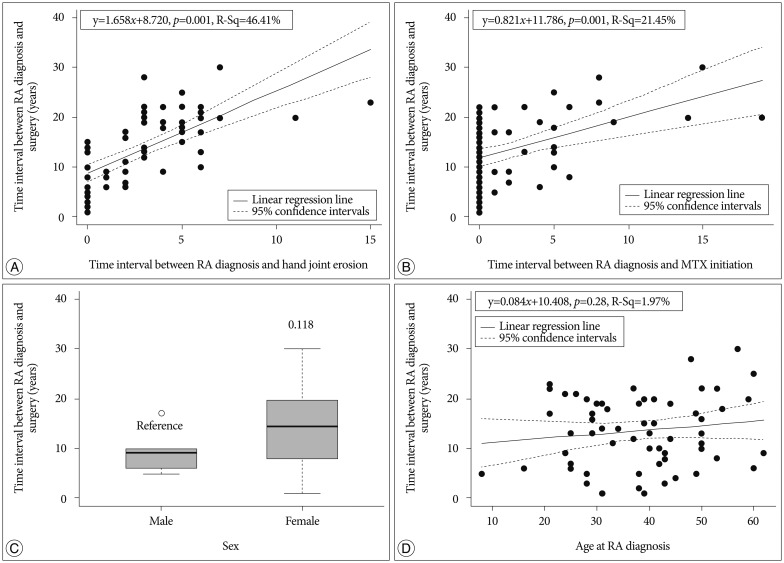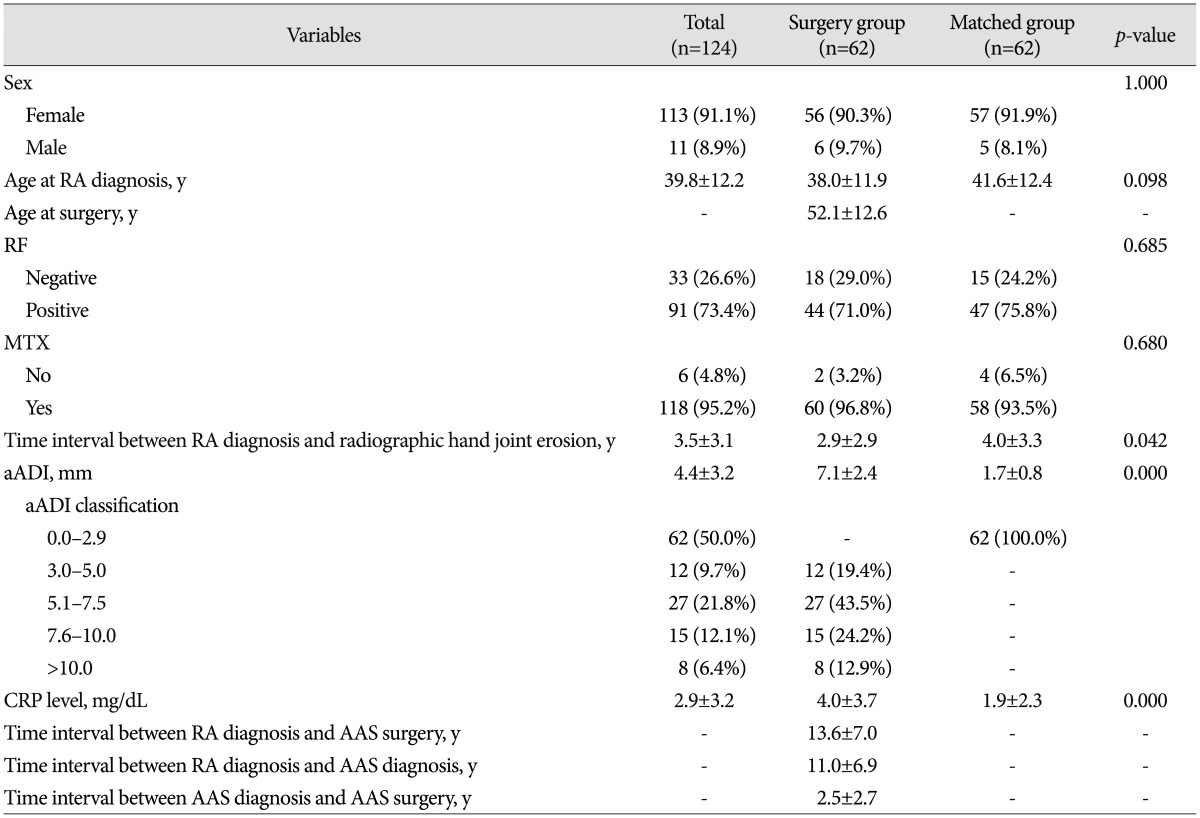1. Ahn JK, Hwang JW, Oh JM, Lee J, Lee YS, Jeon CH. Risk factors for development and progression of atlantoaxial subluxation in Korean patients with rheumatoid arthritis. Rheumatol Int. 2011; 31:1363–1368. PMID:
20422194.

2. Alamanos Y, Drosos AA. Epidemiology of adult rheumatoid arthritis. Autoimmun Rev. 2005; 4:130–136. PMID:
15823498.

3. Arnett FC, Edworthy SM, Bloch DA, McShane DJ, Fries JF, Cooper NS, et al. The American Rheumatism Association 1987 revised criteria for the classification of rheumatoid arthritis. Arthritis Rheum. 1988; 31:315–324. PMID:
3358796.

4. Blom M, Creemers MC, Kievit W, Lemmens JA, van Riel PL. Long-term follow-up of the cervical spine with conventional radiographs in patients with rheumatoid arthritis. Scand J Rheumatol. 2013; 42:281–288. PMID:
23311707.

5. Casey AT, Crockard HA, Bland JM, Stevens J, Moskovich R, Ransford AO. Surgery on the rheumatoid cervical spine for the non-ambulant myelopathic patient-too much, too late? Lancet. 1996; 347:1004–1007. PMID:
8606562.

6. Delamarter RB, Bohlman HH. Postmortem osseous and neuropathologic analysis of the rheumatoid cervical spine. Spine (Phila Pa 1976). 1994; 19:2267–2274. PMID:
7846570.

7. Fujiwara K, Fujimoto M, Owaki H, Kono J, Nakase T, Yonenobu K, et al. Cervical lesions related to the systemic progression in rheumatoid arthritis. Spine (Phila Pa 1976). 1998; 23:2052–2056. PMID:
9794048.

8. Hirano K, Imagama S, Oishi Y, Kanayama Y, Ito Z, Wakao N, et al. Progression of cervical instabilities in patients with rheumatoid arthritis 5.7 years after their first lower limb arthroplasty. Mod Rheumatol. 2012; 22:743–749. PMID:
22245951.

9. Ito H, Neo M, Sakamoto T, Fujibayashi S, Yoshitomi H, Nakamura T. Subaxial subluxation after atlantoaxial transarticular screw fixation in rheumatoid patients. Eur Spine J. 2009; 18:869–876. PMID:
19337758.

10. Joaquim AF, Appenzeller S. Cervical spine involvement in rheumatoid arthritis--a systematic review. Autoimmun Rev. 2014; 13:1195–1202. PMID:
25151973.
11. Kaito T, Hosono N, Ohshima S, Ohwaki H, Takenaka S, Fujiwara H, et al. Effect of biological agents on cervical spine lesions in rheumatoid arthritis. Spine (Phila Pa 1976). 2012; 37:1742–1746. PMID:
22472805.

12. Konttinen YT, Bergroth V, Santavirta S, Sandelin J. Inflammatory involvement of cervical spine ligaments in patients with rheumatoid arthritis and atlantoaxial subluxation. J Rheumatol. 1987; 14:531–534. PMID:
3498036.
13. Mathews JA. Atlanto-axial subluxation in rheumatoid arthritis. A 5-year follow-up study. Ann Rheum Dis. 1974; 33:526–531. PMID:
4441130.

14. Naranjo A, Carmona L, Gavrila D, Balsa A, Belmonte MA, Tena X, et al. Prevalence and associated factors of anterior atlantoaxial luxation in a nation-wide sample of rheumatoid arthritis patients. Clin Exp Rheumatol. 2004; 22:427–432. PMID:
15301239.
15. Oda T, Fujiwara K, Yonenobu K, Azuma B, Ochi T. Natural course of cervical spine lesions in rheumatoid arthritis. Spine (Phila Pa 1976). 1995; 20:1128–1135. PMID:
7638655.

16. Ranawat CS, O'Leary P, Pellicci P, Tsairis P, Marchisello P, Dorr L. Cervical spine fusion in rheumatoid arthritis. J Bone Joint Surg Am. 1979; 61:1003–1010. PMID:
489640.

17. Raskin RJ, Schnapf DJ, Wolf CR, Killian PJ, Lawless OJ. Computerized tomography in evaluation of atlantoaxial subluxation in rheumatoid arthritis. J Rheumatol. 1983; 10:33–41. PMID:
6842484.
18. Reiter MF, Boden SD. Inflammatory disorders of the cervical spine. Spine (Phila Pa 1976). 1998; 23:2755–2766. PMID:
9879101.

19. Renna R, Plantone F, Plantone D. Atlantoaxial subluxation in rheumatoid arthritis. J Rheumatol. 2013; 40:1925. PMID:
24187159.

20. Sharp J, Purser DW. Spontaneous atlanto-axial dislocation in ankylosing spondylitis and rheumatoid arthritis. Ann Rheum Dis. 1961; 20:47–77. PMID:
18623858.

21. van Asselt KM, Lems WF, Bongartz EB, Hamburger HL, Drossaers-Bakker KW, Dijkmans BA, et al. Outcome of cervical spine surgery in patients with rheumatoid arthritis. Ann Rheum Dis. 2001; 60:448–452. PMID:
11302865.

22. van der Heijde DM, van't Hof MA, van Riel PL, van Leeuwen MA, van Rijswijk MH, van de Putte LB. Validity of single variables and composite indices for measuring disease activity in rheumatoid arthritis. Ann Rheum Dis. 1992; 51:177–181. PMID:
1550400.

23. Winfield J, Cooke D, Brook AS, Corbett M. A prospective study of the radiological changes in the cervical spine in early rheumatoid disease. Ann Rheum Dis. 1981; 40:109–114. PMID:
7224682.

24. Yurube T, Sumi M, Nishida K, Miyamoto H, Kohyama K, Matsubara T, et al. Accelerated development of cervical spine instabilities in rheumatoid arthritis : a prospective minimum 5-year cohort study. PLoS One. 2014; 9:e88970. PMID:
24558457.
25. Yurube T, Sumi M, Nishida K, Miyamoto H, Kohyama K, Matsubara T, et al. Incidence and aggravation of cervical spine instabilities in rheumatoid arthritis : a prospective minimum 5-year follow-up study of patients initially without cervical involvement. Spine (Phila Pa 1976). 2012; 37:2136–2144. PMID:
22895480.

26. Zhang T, Pope J. Cervical spine involvement in rheumatoid arthritis over time : results from a meta-analysis. Arthritis Res Ther. 2015; 17:148. PMID:
26026719.






 PDF
PDF ePub
ePub Citation
Citation Print
Print







 XML Download
XML Download